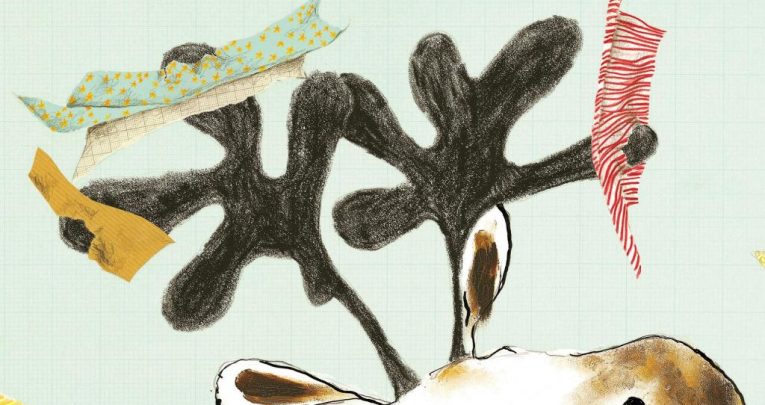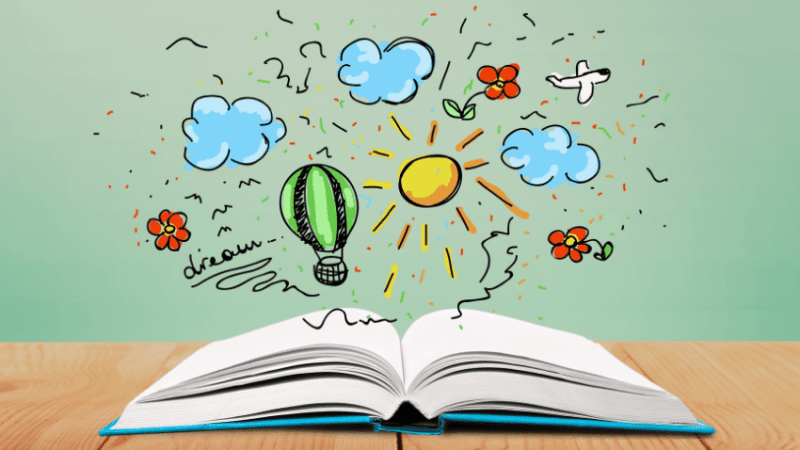10 Lessons You Can Teach Using Powerful Children’s Book Pictures

Great children’s book artwork is the ideal starting point for inspirational topics, says Carey Fluker Hunt…

- by Carey Fluker Hunt
- Creative learning consultant, writer and former teacher Visit website

If you’re struggling for ways to come up with discussion topics to accompany the books your class is studying, use their illustrations as a jumping-off point and see where they take you…
1. Ernest BY CATHERINE RAYNER (Macmillan)
What’s the story?
Ernest is a rather large moose. So large, in fact, that he doesn’t fit inside this book. He tries to squeeze himself onto the pages but it doesn’t work. So it’s lucky for Ernest that he has a very ingenious friend…
Inspiring artwork
Show your class the picture of Ernest’s paper-decorated antlers. Who could this animal be, and why is he peering over the edge of the page? If we could peep inside the book and see all of him, what would he look like? Add a sensory element to the discussion by offering children a basket of patterned and textured paper scraps and asking them to choose the ones they think Ernest would like.
Where will it take you?
Join your paper scraps to create enormous collages and draw on them, or use them to make life-size paper cut-outs of different animals. Actual Size by Steve Jenkins (Frances Lincoln Children’s Books) will help. And why not invent some characters who are friends, despite their differences?
2. The Cow Who Climbed a Tree BY GEMMA MERINO (Macmillan)
What’s the story?
Tina the cow likes to explore the world and is always asking questions. Her sisters disapprove and want her to behave properly, like them. But one day they follow Tina into the woods and discover what they’ve been missing. Merino’s charmingly quirky illustrations capture the mood completely.
Inspiring artwork
Look at the picture of the three cows walking through the wood. What can they see, and how are they feeling? Create a soundscape by asking each child to make a woodland noise (leaves swishing, wind whistling, owls hooting). On a given signal, ask everyone to make their chosen sound together.
What do you notice about the leaves on the trees? Do they look like real trees, or are they more like patterns? Look through circles of coloured tissue paper. Tape them to a window so that the circles overlap. What happens to the colours? Cut long, thin rectangles of paper and add them to the circles to make them look like Merino’s trees.
Where will it take you?
Tina wants to learn all about the world. Bring a soft toy cow into the classroom and tell her some interesting facts that you’ve discovered.
Merino creates her illustrations using monoprints, then colours them digitally. Use print techniques and inks to make a woodland scene based on her work.
What would you do, if you were going to try something new and wonderful? Talk about it!
3. Otto the Book Bear BY KATIE CLEMINSON (Jonathan Cape)
What’s the story?
Otto is a tiny bear who lives inside a book. One day his family moves house, leaving him behind, and he has to find a new home at the library. Luckily for Otto, there are plenty of other book-dwelling characters there to keep him company.
Inspiring artwork
Look at the picture of Otto staring at the van. Who is this bear, and how is he feeling? What might be going to happen next?
Give each child a teddy bear. Ask them to look out of the classroom window and talk to the bears about what they can see. Might these bears have other, secret lives that we don’t know about?
Where will it take you?
Invent names and characters for the bears. Make up stories about their adventures.
Visit a library to discover tiny toys hiding on the bookshelves. Read some stories to the toys – such as Bears Don’t Read by Emma Chichester Clark – and make a library of tiny books for Otto. Role-play working in a library (complete with rubber stamps and index cards) and lend books to the teddy bears.
4. Welcome to Your Awesome Robot BY VIVIANE SCHWARZ (Flying Eye Books)
What’s the story?
This is an activity book, a comicstrip story and an instruction manual all in one. Written, designed and illustrated by creative innovator Viviane Schwarz, Welcome to Your Awesome Robot is good for ‘hooking’ children who aren’t usually book-focused, but it will be enjoyed by all.
Inspiring artwork
Show your class the picture of the unopened box. We know it contains a robot, but what kind of robot? Ask your class to draw and describe it. Try moving and speaking like a robot, and talk about the tasks you might have to do.
As well as conveying meaning, the text in this illustration is visually important. How are the words and speech bubbles arranged on the page, and what does this tell you about how the words should sound?
This image has a white background, which means the action could be happening anywhere. Talk about possible settings for the book and imagine what might be going to happen next.
Where will it take you?
Fill a large, sealed cardboard box with ‘odd objects’ and ask your class to imagine what could be inside. Explore the objects, then choose three and design a robot incorporating these parts. Draw annotated diagrams, or write a story about your robot.
As a class, investigate a practical process (such as making a salad or wrapping a present) and draw a strip cartoon explaining how it should be done.
Use computer-aided design kits to make and control small models or robots – or dress up as robots, using cardboard boxes, and choreograph a robot dance!
5. Ike’s Incredible Ink BY BRIANNE FARLEY (Walker Books)
About the book
Ike is a ‘can-do’ character who’s on a mission to make himself some ink – but Ike’s concoction will be unusual, to say the least. Offbeat practicality and expressive inkblots make this a memorable read.
Inspiring artwork
Look at the picture of Ike and the blender. What’s going on, and what do you notice about the character involved? Why has so much of the page been left blank, do you think?
Pass around a clear, sealed container of black ink, tipping it to observe its movement. Think of as many words to describe it as you can.
Explore this image physically by jumping up and out of the blender, like the ink. Then show how Ike reacts to all the mess.
Where will it take you?
Drop small amounts of ink or paint onto large sheets of paper to create blots. What do they look like? When they’re dry, add details using fine black pens to create characters. Choose your favourite character and let it star in a story, then make up some Ike-style recipes for different colours of ink.
Find out about real ink and how it’s made. Are there any (safe) ingredients you could experiment with to create some ink that you could use?
6. Traction Man is Here BY MINI GREY (Random House)
What’s the story?
Traction Man is a toy who battles evil wherever he finds it – even in the kitchen sink. Grey mixes real-world scenarios with Traction Man’s exploits (and full-page illustrations with a busier, multi-frame approach) to create a funny and satisfying story about the power of imaginative play.
Inspiring artwork
Look at the picture showing Traction Man searching for the Lost Wreck. How do we know that Traction Man is in a sink? This image captures a frozen moment (like a film still, or single graphic-novel panel). What happened before this moment, and what will happen afterwards?
Pretend to be the Evil Dishcloth and creep up on Traction Man!
Where will it take you?
Make a collection of household objects (like the sieve) for Traction Man: The Sequel. What could each object become? Record ideas by drawing and annotating, then develop into graphic-novel-style stories. If toys could come to life, what adventures would they have?
Provide capes and masks for superhero role play, or help children make their own. Do girl superheroes behave differently to boy superheroes? Talk about stereotypes and the way that Traction Man and the Dollies are depicted in this book. Tell a story about the time the Dollies had to rescue Traction Man, instead.
Read Send for A Superhero by Michael Rosen and Katharine McEwan (Walker) and compare it with Traction Man is Here. Which do you prefer, and why?
7. Little Beauty BY ANTHONY BROWNE (Walker Books)
What’s the story?
Based on a true story, this book is about a gorilla who is the subject of a language and communications experiment. Anthony Browne’s illustrations are always rewarding to explore with children, who notice more than we expect. Here, Browne marries his images with a sparse text that takes us right to the heart of what it means to be human, and the responsibility we have to the animals with which we interact.
Inspiring artwork
Look at the picture of the gorilla smashing the TV. What do you think the gorilla is thinking and feeling – and how does the illustrator tell us this? (For example, red background, clenched fist, deep frown). Explore the emotional landscape of this picture by copying the gorilla’s posture and role-playing what happens next.
Where will it take you?
Find out about apes and the Washoe/Koko experiments. If you could communicate with animals, what would you ask them and what might they tell you?
Learn some sign language and communicate without words. Make up your own new language and use it to say something.
Talk about friendship and why it’s important. How do we express our emotions? Do animals feel emotions, too – and how can we tell? Talk to people who have pets to find out what they think.
8. A Lion in Paris BY BEATRICE ALEMAGNA (Tate Publishing)
About the book
This gorgeously oversized book opens via a landscape fold to tell the story of an African lion newly-arrived in Paris. Lonely but intrigued, he tours the city and sees all sorts of marvels. Finally he discovers his ‘perfect place’ – a plinth in the middle of a busy roundabout. Alemagna’s detailed and decorative illustrations repay close observation (and statues will never look quite the same again!).
Inspiring artwork
Show your class the picture of the lion in the café. Which is the main character, and how can we tell? Who might the other people be, and what could they be thinking about? What kind of setting is this, and can your children guess at its location? Look closely at the illustration and talk about the materials used to create it (collage, pencil, gouache). Many textures are suggested, such as the café’s ironwork and the richly-patterned coat. How have these been realised, and what other patterns and textures can you find?
Where will it take you?
Use role plays and other drama exercises to explore ideas like leaving home and loneliness in a new place and use this to lead into discussion about refugees and migration.
Visit a statue in your local area and draw it – or research statues online. Make an interactive map showing their location and history. Role-play a statue that comes to life, then write about it.
Find out more about Paris, and be inspired by Alemagna’s artwork to create urban landscape collages of your own.
And if you’re enjoying the living statues idea, try Stoneheart by Charlie Fletcher (9+).
9. The General BY JANET CHARTERS AND MICHAEL FOREMAN (Templar)
About the book
What would the world be like if we said no to war? Foreman’s General is bristling with medals and has an insatiable appetite for invasion and conquest. Will he ever change his mind?
First published more than 50 years ago at the height of the Cold War, this book still feels as fresh and relevant as ever.
Inspiring artwork
Show your class the picture of the nightmare. Who could the man be, and what is he dreaming about? Role-play the moment at which he wakes. What will he say about his nightmare, and how will he interpret it?
Describe exactly what you can see in this picture, and talk about the way this has been realised – both stylistically and technically. Your children don’t need to use the ‘correct’ language, but they do need to look closely and question what they see. For example, how does the depiction of the soldiers’ legs differ from that of the man in bed (heavy black lines, etc) and how has the darkness been suggested?
Where will it take you?
What kind of leader must the General become? Find out about the actions and resources necessary to keep a country happy and prosperous.
How should a country treat its neighbours? Role-play scenarios that could end well or badly for the country involved, depending on the decisions made. Look at newspaper reports about the actions of leaders around the world and discuss.
Be inspired by Foreman’s artwork to create large-scale murals of landscapes, or a stylised aerial view of the area in which you live.
10. A Lion in Paris BY BEATRICE ALEMAGNA (Tate Publishing)
About the book
In this sophisticated but lowkey take on the traditional tale, Red Riding Hood is played by a surprisingly expressive stick-girl in a red cape, and the wolf by a ragged (and very wily) assortment of pencil marks. The postures and dialogue give this book the air of a piece of theatre trapped on the page. It’s also very funny.
Inspiring artwork
Show your class the picture of the wolf shouting “joooosey red meat!” Which story does this picture come from, and how can you tell? What makes Red Riding Hood such a well-known tale? Look at the body language of the characters in this image. Ask children to recreate their postures and expressions. What is Little Red Hood thinking, and what might she be about to say?
This illustration has a plain white background. What impact does this have on the viewer? And what do your class think about the way the characters have been drawn? It looks almost as if the illustrator has been scribbling, but the outcome is far from random. Give children soft graphite pencils and ask them to experiment using a similar approach. What happens if you introduce a single colour to your sketch?
Where will it take you?
Share the whole book, then recreate each illustration ‘tableaustyle’, ensuring that children pay attention to their body language and posture. Bring each tableau to life in a series of mini-dramas, then join them to make a play – and video it!
If you cover the illustrations, how much needs to be added to the text to make the story interesting and complete? Expand the text to include details and descriptions, as well as more dialogue, taking care that the original characterisations are maintained.
Have fun applying Leroy’s approach to different stories to make a folktale library.
Carey Fluker Hunt is a freelance writer, children’s book ambassador and creative consultant.










